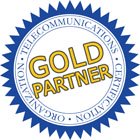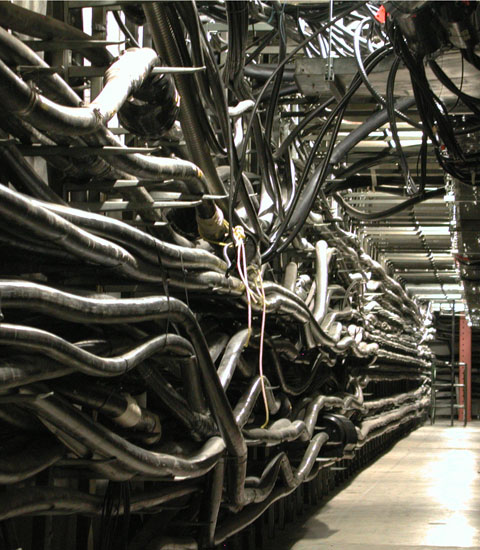Study Guide Notes For This Lesson
These are the words that are displayed and spoken during the lesson. Get these notes for the whole course in the Certification Study Guide, available in print or eBook. Many people tell us a printed companion book enhances their learning!
The access is the physical connection between the user and the network. It is also called the last mile. This circuit is the face of the telecom network to users.
Service is usually billed on a per-access basis, and usually coupled with a network address.
There are many types of access circuits, all covered in detail in subsequent CTNS courses. To get started, we group them by technology: copper, fiber and wireless.
It all started with telephone companies and two copper wires called a loop, insulated and twisted together to minimize noise pickup. Since there are two wires twisted together, this is also referred to as twisted pair.
Plain Ordinary Telephone Service (POTS) is implemented using voltage analogs of speech on the loop. Digital Subscriber Line (DSL) implements broadband communications on the loop using modems. T1 business services use voltage pulses on twisted pair.
Though they are strictly speaking an in-building customer premise technology, LAN cables, both the cables in the walls and the famous blue LAN patch cables with connectors at each end are made with twisted pair.
Coaxial cable or coax is also two copper wires; one inside the other instead of side by side. The outer wire is hollow like a pipe, and the other wire runs inside the pipe.
This geometry allows the transmission of very high frequency signals using voltage analogs and modem signals, so compared to twisted pair, much more information including television signals and high-speed Internet can be communicated.
Of course, nothing is free: the maximum practical length of coax is about 1/10 that of twisted pair. The solution is to transport the signal on fiber to the neighborhood then on coax copper to the premise, called a Hybrid Fiber-Coax (HFC) system, to implement a Community Antenna Television (CATV) service, commonly called cable TV.
With the coming advances in bandwidth and coverage of HFC and wireless access, telephone companies with an installed base of twisted-pair copper loops, called Incumbent Local Exchange Carriers (ILECs), had to decide if they wanted to continue in that business, as the twisted pair loops can not support enough bandwidth to compete with future wireless and HFC.
Continuing in the wired-access to residence model means pulling a fiber to every residence.
Pulling a fiber past every residence is an expensive and time-consuming project, but leapfrogs all other technologies in bandwidth, erecting a business barrier against any competition being able to deliver more bandwidth for the foreseeable future.
Telephone companies are provisioning Optical Ethernet for business customers and Passive Optical Network (PON) links to residences.
When a neighborhood is “fibered”, many dark fibers for future use as backhaul for future short-range ultra-high-capacity wireless access is installed. The incremental cost is low, and having the wiring for such a system pre-installed may be a cost differentiator between the ILEC and a wireless competitor in the future.
Wireless systems can be fixed or mobile.
Fixed wireless is access using radio between an antenna on a tower and an antenna on a building communicating at frequencies like 2.5 and 3.5 GHz. Wi-Fi is of course a type of fixed wireless, but fits into the customer premise equipment category rather than telecom services.
Mobile wireless means many radio base stations, each with multiple antennas pointing in different directions so that there is radio coverage in a large geographic area, and a system of handing off the user from one base station to the next as either the user moves around (cellphones) and/or the base stations move around (Low Earth Orbit LEO satellite phones).
The Universal Terrestrial Radio Access Network Long-Term Evolution (LTE) standard is also referred to as the fourth generation (4G) of mobile cellular. LTE radio is also used in fixed wireless.
The fifth generation (5G) brings 40% more spectral efficiency (bits per Hertz) plus the beginnings of massive bandwidth for end-users using Multiple-Input, Multiple-Output (MIMO) a type of spatial multiplexing, heading toward 1 Gb/s download speed.
Geosynchronous Earth Orbit (GEO) is 22,300 miles above the surface of the earth above the equator. At this radius, the orbital velocity is the same as rotational velocity of the earth, so the satellite appears to be stationary to an earthbound antenna. Communicating with one from a very northern latitude would be the longest access circuit.
In this lesson, we have introduced the technologies used for the "last mile", organizing them into copper, fiber and wireless.
As this is the introductory course, we have named the technologies, mostly without explaining how they work. The detailed network diagrams seen in this lesson are taken from subsequent courses, where we explain all of this in more detail.
POTS, DSL and T1s installed by the ILEC all run on twisted pair down the street. LAN cables also use twisted pair, but are in the customer-premise category and not telecom access circuits.
Coax supports much wider frequency bands, but short lengths. Hybrid Fiber-Coax systems deliver analog TV and modem signals in frequency channels to the neighborhood on fiber, distributed down the street on coax.
Fiber means using a glass tube to guide light from A to B, and changing the light to indicate 1s and 0s. Most systems use on/off. Expensive ones implement modems using light. In Optical Ethernet, the 1s and 0s are MAC frames.
Businesses typically get a dedicated fiber, sometimes called Active Ethernet, because residences typically use a shared fiber backhaul, called a Passive Optical Network.
Fixed wireless means broadband wireless to residences from a tower. A mobile network adds handoffs from one tower to the next allowing users to move around without losing a call.
With 5G and MIMO, actual downloading speeds of 1 Gb/s are in reach.
Satellite communications would be the longest "last mile" technology... closer to 30,000 miles to a geosynchronous satellite from Yellowknife.














 Cable Vault in the Basement of a Central Office
Cable Vault in the Basement of a Central Office
